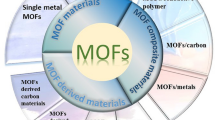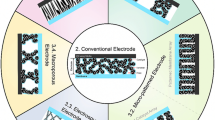Abstract
Electrochemical double-layer capacitors are promising energy storage devices with high power density, moderate energy density, rapid charging rates, and high cycle life. In order to maximize energy density, highly porous carbon materials are often incorporated in the electrodes. The structure of the porous carbon network is critical to ensure high power delivery and charging rate. In this study, two types of oil sands petroleum cokes, from either batch or continuous industrial coking, were used to prepare porous carbon samples. The two activated petroleum coke samples have similar chemical compositions, specific surface areas, and pore size distributions, but due to the different industrial coking methods, the two samples have differing macrostructures and porous networks. Using mercury intrusion porosimetry and scanning electron microscopy, the meso-structure, macrostructure, and pore connectivity of the two samples were characterized and compared to the capacitance performance of the activated coke samples. The results show that, in order to ensure high rate performance, especially in ion depleted electrolyte scenarios, the porous carbon samples must have an interconnected network of pores between 10 and 1000 nm in diameter. These pore sizes are shown to improve the rate of ion diffusion, and allow greater capacitance values to be achieved at rapid charging rates.
Graphical abstract





Similar content being viewed by others
References
Conway BE (1999) Electrochemical supercapacitors, scientific fundamentals and technological applications. Kluwer Academic, Ottawa
Burke A (2000) Ultracapacitors: why, how, and where is the technology. J Power Sources 91:37–50. doi:10.1016/s0378-7753(00)00485-7
Kotz R, Carlen M (2000) Principles and applications of electrochemical capacitors. Electrochim Acta 45:2483–2498. doi:10.1016/S0013-4686(00)00354-6
Pandolfo AG, Hollenkamp AF (2006) Carbon properties and their role in supercapacitors. J Power Sources 157:11–27. doi:10.1016/j.jpowsour.2006.02.065
Frackowiak E, Beguin F (2001) Carbon materials for the electrochemical storage of energy in capacitors. Carbon 39:937–950. doi:10.1016/s0008-6223(00)00183-4
Ghosh A, Lee YH (2012) Carbon-based electrochemical capacitors. Chem Sus Chem 5:480–499. doi:10.1002/cssc.201100645
Gu WT, Yushin G (2014) Review of nanostructured carbon materials for electrochemical capacitor applications: advantages and limitations of activated carbon, carbide-derived carbon, zeolite-templated carbon, carbon aerogels, carbon nanotubes, onion-like carbon, and graphene. WIREs-Energy Environ 3:424–473. doi:10.1002/wene.102
Inagaki M, Konno H, Tanaike O (2010) Carbon materials for electrochemical capacitors. J Power Sources 195:7880–7903. doi:10.1016/j.jpowsour.2010.06.036
Zhai YP, Dou YQ, Zhao DY, Fulvio PF, Mayes RT, Dai S (2011) Carbon materials for chemical capacitive energy storage. Adv Mater 23:4828–4850. doi:10.1002/adma.201100984
Zhang LL, Zhao XS (2009) Carbon-based materials as supercapacitor electrodes. Chem Soc Rev 38:2520–2531. doi:10.1039/b813846j
Davies A, Yu A (2011) Material advancements in supercapacitors: from activated carbon to carbon nanotube and graphene. Can J Chem Eng 89:1342–1357. doi:10.1002/cjce.20586
Simon P, Gogotsi Y (2008) Materials for electrochemical capacitors. Nat Mater 7:845–854. doi:10.1038/nmat2297
Simon P, Gogotsi Y (2013) Capacitive energy storage in nanostructured carbon-electrolyte systems. Acc Chem Res 46:1094–1103. doi:10.1021/ar200306b
Frackowiak E, Abbas Q, Beguin F (2013) Carbon/carbon supercapacitors. J Energ Chem 22:226–240. doi:10.1016/S2095-4956(13)60028-5
Beguin F, Presser V, Balducci A, Frackowiak E (2014) Carbons and electrolytes for advanced supercapacitors. Adv Mater 26:2219–2251. doi:10.1002/adma.201304137
Simon P, Gogotsi Y (2010) Charge storage mechanism in nanoporous carbons and its consequence for electrical double layer capacitors. Philos Trans R Soc A 368:3457–3467. doi:10.1098/rsta.2010.0109
Chmiola J, Yushin G, Gogotsi Y, Portet C, Simon P, Taberna PL (2006) Anomalous increase in carbon capacitance at pore sizes less than 1 nanometer. Science 313:1760–1763. doi:10.1126/science.1132195
Chmiola J, Largeot C, Taberna PL, Simon P, Gogotsi Y (2008) Desolvation of ions in subnanometer pores and its effect on capacitance and double-layer theory. Angew Chem 120:3440–3443. doi:10.1002/ange.200704894
Alonso A, Ruiz V, Blanco C, Santamaria R, Granda M, Menendez R, de Jager SGE (2006) Activated carbon produced from sasol-lurgi gasifier pitch and its application as electrodes in supercapacitors. Carbon 44:441–446. doi:10.1016/j.carbon.2005.09.008
Kierzek K, Frackowiak E, Lota G, Gryglewicz G, Machnikowski J (2004) Electrochemical capacitors based on highly porous carbons prepared by KOH activation. Electrochim Acta 49:515–523. doi:10.1016/j.electacta.2003.08.026
Centeno TA, Stoeckli F (2006) On the specific double-layer capacitance of activated carbons, in relation to their structural and chemical properties. J Power Sources 154:314–320. doi:10.1016/j.jpowsour.2005.04.007
Centeno TA, Fernandez JA, Stoeckli F (2008) Correlation between heats of immersion and limiting capacitances in porous carbons. Carbon 46:1025–1030. doi:10.1016/j.carbon.2008.03.005
Centeno TA, Sereda O, Stoeckli F (2011) Capacitance in carbon pores of 0.7 to 15 nm: a regular pattern. Phys Chem Chem Phys 13:12403–12406. doi:10.1039/c1cp20748b
Lazzari M, Soavi F, Mastragostino M (2010) Mesoporous carbon design for ionic liquid-based, double-layer supercapacitors. Fuel Cells 10:840–847. doi:10.1002/fuce.200900198
Jäckel N, Rodner M, Schreiber A, Jeongwook J, Zeiger M, Aslan M, Weingarth D, Presser V (2016) Anomalous or regular capacitance? the influence of pore size dispersity on double-layer formation. J Power Sources 326:660–671. doi:10.1016/j.jpowsour.2016.03.015
Chmiola J, Yushin G, Dash R, Gogotsi Y (2006) Effect of pore size and surface area of carbide derived carbons on specific capacitance. J Power Sources 158:765–772. doi:10.1016/j.jpowsour.2005.09.008
Kondrat S, Kornyshev A (2011) Superionic state in double-layer capacitors with nanoporous electrodes. J Phys 23:022201. doi:10.1088/0953-8984/23/2/022201
Kondrat S, Perez CR, Presser V, Gogotsi Y, Kornyshev AA (2012) Effect of pore size and its dispersity on the energy storage in nanoporous supercapacitors. Energy Environ Sci 5:6474–6479. doi:10.1039/c2ee03092f
Merlet C, Rotenberg B, Madden PA, Taberna PL, Simon P, Gogotsi Y, Salanne M (2012) On the molecular origin of supercapacitance in nanoporous carbon electrodes. Nat Mater 11:306–310. doi:10.1038/nmat3260
Levi MD, Sigalov S, Salitra G, Aurbach D, Maier J (2011) The effect of specific adsorption of cations and their size on the charge-compensation mechanism in carbon micropores: the role of anion desorption. Chem Phys Phys Chem 12:854–862. doi:10.1002/cphc.201000653
Levi MD, Sigalov S, Salitra G, Elazari R, Aurbach D (2011) Assessing the solvation numbers of electrolytic ions confined in carbon nanopores under dynamic charging conditions. J Phys Chem Lett 2:120–124. doi:10.1021/jz1016922
Daffos B, Taberna PL, Gogotsi Y, Simon P (2010) Recent advances in understanding the capacitive storage in microporous carbons. Fuel Cells 10:819–824. doi:10.1002/fuce.200900192
Chathoth SM, Mamontov E, Kolesnikov AI, Gogotsi Y, Wesolowski DJ (2011) Quasielastic neutron scattering study of water confined in carbon nanopores. EPL 95:56001. doi:10.1209/0295-5075/95/56001
Tsai WY, Taberna PL, Simon P (2014) Electrochemical quartz crystal microbalance (EQCM) study of ion dynamics in nanoporous carbons. J Am Chem Soc 136:8722–8728. doi:10.1021/ja503449w
Merlet C, Pean C, Rotenberg B, Madden PA, Daffos B, Taberna PL, Simon P, Salanne M (2013) Highly confined ions store charge more efficiently in supercapacitors. Nat Commun 4:2701. doi:10.1038/ncomms3701
Garcia-Gomez A, Barranco V, Moreno-Fernandez G, Ibanez J, Centeno TA, Rojo JM (2014) Correlation between capacitance and porosity in microporous carbon monoliths. J Phys Chem C 118:5134–5141. doi:10.1021/jp411076a
Ohkubo T, Konishi T, Hattori Y, Kanoh H, Fujikawa T, Kaneko K (2002) Restricted hydration structures of Rb and Br ions confined in slit-shaped carbon nanospace. J Am Chem Soc 124:11860–11861. doi:10.1021/ja027144t
Zuliani JE, Tong S, Kirk DW, Jia CQ (2015) Isolating the effect of pore size distribution on electrochemical double-layer capacitance using activated fluid coke. J Power Sources 300:190–198. doi:10.1016/j.jpowsour.2015.09.030
Wang DW, Li F, Liu M, Lu GQ, Cheng HM (2009) 3D aperiodic hierarchical porous graphitic carbon material for high-rate electrochemical capacitive energy storage. Angew Chem Int Ed Engl 47:373–376. doi:10.1002/anie.200702721
Korenblit Y, Rose M, Kockrick E, Borchardt L, Kvit A, Kaskel S, Yushin G (2010) High-rate electrochemical capacitors based on ordered mesoporous silicon carbide-derived carbon. ACS Nano 4:1337–1344. doi:10.1021/nn901825y
Li Y, Fu ZY, Su BL (2012) Hierarchically structured porous materials for energy conversion and storage. Adv Funct Mater 22:4634–4667. doi:10.1002/adfm.201200591
Kim M, Oh I, Kim J (2015) Supercapacitive behavior depending on the mesopore size of three-dimensional micro-, meso- and macroporous silicon carbide for supercapacitors. Phys Chem Chem Phys 17:4424–4433. doi:10.1039/c4cp05357e
Qu D, Shi H (1998) Studies of activated carbons used in double-layer capacitors. J Power Sources 74:99–107. doi:10.1016/S0378-7753(98)00038-X
Yamada Y, Sasaki T, Tatsuda N, Weingarth D, Yano K, Kötz R (2012) A novel model electrode for investigating ion transport inside pores in an electrical double-layer capacitor: monodispered microporous starburst carbon spheres. Electrochim Acta 81:138–148. doi:10.1016/j.electacta.2012.07.064
Wu ZS, Sun Y, Tan YZ, Yang SB, Feng XL, Mullen K (2012) Three-dimensional graphene-based macro- and mesoporous frameworks for high-performance electrochemical capacitive energy storage. J Am Chem Soc 134:19532–19535. doi:10.1021/ja308676h
Furimsky E (2000) Characterization of cokes from fluid/flexi-coking of heavy feeds. Fuel Process Technol 67:205–230. doi:10.1016/s0378-3820(00)00103-x
DiPanfilo R, Egiebor NO (1996) Activated carbon production from synthetic crude coke. Fuel Process Technol 46:157–169. doi:10.1016/0378-3820(95)00054-2
Zuliani JE, Kirk DW, Jia CQ, Tong S (2014) Activated oil sands fluid coke for electrical double-layer capacitors. J Power Sources 271:326–333. doi:10.1016/j.jpowsour.2014.07.171
Yuan M, Kim Y, Jia CQ (2012) Feasibility of recycling koh in chemical activation of oil-sands petroleum coke. Can J Chem Eng 90:1472–1478. doi:10.1002/cjce.20671
Furimsky E (1998) Gasification of oil sand coke: review. Fuel Process Technol 56:263–290. doi:10.1016/S0378-3820(98)00048-4
Cai JH, Jia CQ (2010) Mercury removal from aqueous solution using coke-derived sulfur-impregnated activated carbons. Ind Eng Chem Res 49:2716–2721. doi:10.1021/ie901194r
Jagiello J, Ania C, Parra JB, Cook C (2015) Dual gas analysis of microporous carbons using 2D-NLDFT heterogeneous surface model and combined adsorption data of N2 and CO2. Carbon 91:330–337. doi:10.1016/j.carbon.2015.05.004
Caguiat JN, Kirk DW, Jia CQ (2014) Uncertainties in characterization of nanoporous carbons using density functional theory-based gas physisorption. Carbon 72:47–56. doi:10.1016/j.carbon.2014.01.036
Brunauer S, Deming LS, Deming WE, Teller E (1940) On a theory of the van der Waals adsorption of gases. J Am Chem Soc 62:1723–1732. doi:10.1021/ja01864a025
Sing KSW, Everett DH, Haul RAW, Moscou L, Pierotti RA, Rouquerol J, Siemieniewska T (1985) Reporting physisorption data for gas/solid systems, with special references to the determination of surface area and porosity. Pure Appl Chem 57:603–619
Giesche H (2006) Mercury porosimetry: a general (practical) overview. Part Part Sts Char 23:9–19. doi:10.1002/ppsc.200601009
Chen CM, Zhang Q, Zhao XC, Zhang B, Kong QQ, Yang MG, Yang QH, Wang MZ, Yang YG, Schlogl R, Su DS (2012) Hierarchically aminated graphene honeycombs for electrochemical capacitive energy storage. J Mater Chem 22:14076–14084. doi:10.1039/C2JM31426F
Oh YJ, Yoo JJ, Kim YI, Yoon JK, Yoon HN, Kim J-H, Park SB (2014) Oxygen functional groups and electrochemical capacitive behavior of incompletely reduced graphene oxides as a thin-film electrode of supercapacitor. Electrochim Acta 116:118–128. doi:10.1016/j.electacta.2013.11.040
Fang Y, Luo B, Jia Y, Li X, Wang B, Song Q, Kang F, Zhi L (2012) Renewing functionalized graphene as electrodes for high-performance supercapacitors. Adv Mater 24:6348–6355. doi:10.1002/adma.201202774
Acknowledgements
The authors would like to acknowledge the Natural Science and Engineering Research Council (NSERC), the Consortium on Sustainable Materials (COSM-Japan) and the Chinese–NSF for funding for this project. As well, the authors would like to thank the Canadian Oil Sands industry for supply of raw petroleum coke. The authors would also like to thank Professor Tim Newson and Dr. Nael Yasri from Western University for their help with the Mercury Intrusion Porosimetry analysis. The authors would also like to thank Dr. Rana Sodhi from the University of Toronto for his help with the X-ray photoelectron spectroscopy analysis.
Author information
Authors and Affiliations
Corresponding author
Electronic supplementary material
Below is the link to the electronic supplementary material.
Rights and permissions
About this article
Cite this article
Zuliani, J.E., Jia, C.Q. & Kirk, D.W. Exploring the effects of carbon meso-structure and macrostructure on the rate performance of porous carbon supercapacitors. J Appl Electrochem 47, 1213–1226 (2017). https://doi.org/10.1007/s10800-017-1123-9
Received:
Accepted:
Published:
Issue Date:
DOI: https://doi.org/10.1007/s10800-017-1123-9




